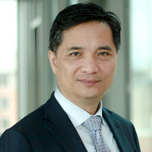Engineering stem cells and biomaterials for neuromuscular regeneration

1-2 p.m., March 26, 2021
Song Li, PhD
Chair
Department of Bioengineering
University of California, Los Angeles
ABSTRACT: Traumatic nerve injury often results in muscle dysfunction, disability and mortality and the development of effective therapy remains a challenge. To address this unmet medical need, we have taken a multidisciplinary approach, including stem cell delivery, drug delivery and wireless electrical stimulation, to accelerate axon growth, enhance reinnervation and promote muscle regeneration.
A limiting step in functional recovery is the regeneration of neuromuscular junctions (NMJs). We developed a synthetic neuromuscular tissue platform by engineering the co-culture of motor neurons and muscle stem cells on micro- and nano-patterned substrates as an in vitro model of NMJ formation. We found that the spheroids of neural crest stem cells (NCSCs) not mesenchymal stem cells significantly improved NMJ formation in this synthetic tissue model. Consistently, intramuscular transplantation in a rat model of peripheral nerve (PN) transection injury showed that NCSC spheroids significantly improved the survival of transplanted cells, the formation of NMJs and the functional recovery of muscle.
To enhance muscle regeneration, we identified a chemical cocktail that selectively induced a robust expansion of myogenic stem cells from readily obtainable dermal cells and from muscle stromal cells. Both stem cell transplantation and in situ activation of resident satellite cells by drug delivery enhanced muscle regeneration in adult and aged mice. Furthermore, we developed a wireless, bioresorbable and stretchable electrical stimulator and showed that repetitive electrical stimulation on the distal nerve stump promoted NMJ formation and functional recovery, demonstrating the potential of biophysical therapy.
These findings and technologies can be translated into innovative therapies for neuromuscular regeneration and may have broad applications for regenerative engineering.
BIOGRAPHY: Li completed his PhD and postdoctoral training in bioengineering at the University of California, San Diego. He was a professor of bioengineering at the University of California, Berkeley between 2001 and 2015, where he served as a co-chair of the UC Berkeley-UCSF Graduate Program and a co-director of the Master of Translational Medicine Program. In 2016, Li joined the bioengineering faculty at the University of California, Los Angeles. Currently a chancellor professor and the chair of the Bioengineering Department at The University of Texas at Dallas with a joint appointment in the Department of Medicine, Li focuses his research on cell engineering, biomaterials, drug delivery, mechanobiology and regenerative engineering. He takes an interdisciplinary approach to developing therapeutics by engineering stem cells and micro-/nanomaterials. His research also advances the understanding of how biophysical factors regulate cell reprogramming and tissue remodeling. Besides filing over 10 patent applications, Li actively translates his research findings into biomedical applications.
Li has been elected as a fellow of the American Institute of Medical and Biological Engineering, a fellow of the Biomedical Engineering Society and a fellow of the International Academy of Medical and Biological Engineering.




